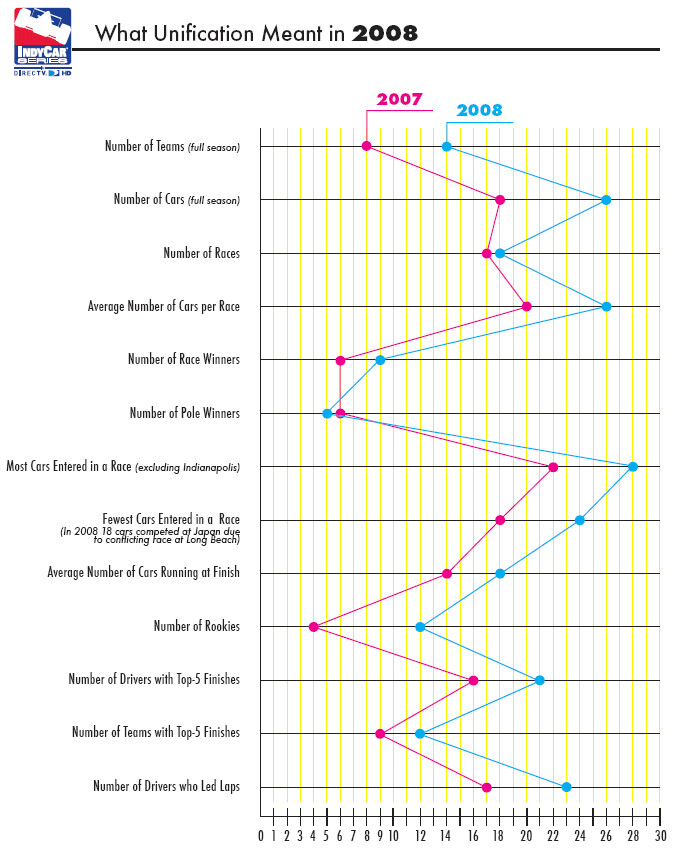Unification Spurred Ultra-Competitive IndyCar Season
While everyone celebrated the unification of open-wheel racing and a more than 40 percent jump in the number of cars on track, they also knew it would be much more difficult to win races and the championship.
That fact became clearly evident the second week of the season when newcomer Graham Rahal won on the streets of St. Petersburg in his series debut, the fourth driver to win his first IndyCar Series start and the youngest driver (19 years, 93 days old) to win a major open-wheel race. Rahal’s record-setting win was followed by another historic moment just weeks later when Danica Patrick became the first female winner of a major closed-circuit auto racing event, the Japan Indy 300.
“It was a fantastic season," said Brian Barnhart, president of competition and operations for the Indy Racing League, sanctioning body of the IndyCar Series. “Everyone recognized that unification was the single most important thing that needed to happen to lay the foundation for the future growth of open-wheel racing. There were a number of factors that were challenges – getting cars to people, the demand on Honda for engines and tire supply from Firestone. When you consider we were about six weeks away from the first race (when unification was announced), we faced some pretty steep odds of getting it done. But I really can’t imagine the season going much better than it did."
The drama continued at the 92nd Indianapolis 500. Fans were treated to a true round of bumping on the last day of time trials – Bump Day – with Mario Dominguez and Buddy Lazier dueling for the last spot in the 33-car field right up to the sounding of the gun to end qualifying.
Summer months saw Ryan Briscoe, Kanaan, Ryan Hunter-Reay, Helio Castroneves and Wilson all reach Victory Lane.
 |
| 2007 vs. 2008 comparison chart |
With three races remaining in the season, Dixon held a 78-point lead in the championship standings over second place Castroneves. But with a win at Infineon and a runner-up finish at Belle Isle, the two-time Indy 500 winner closed the margin to 30 points entering Chicagoland Speedway. To earn the series title, Dixon needed to finish eighth or better in the season finale. Ultimately, Castroneves beat Dixon to the checkered flag by .0033 of a second – the second-closest finish in IndyCar Series history, but Dixon won the championship.
“I’d really be hard-pressed to find anything that could have gone better," Barnhart said. “Beginning with equipment acquisition, the familiarization with the teams coming over and joining the IndyCar Series and getting them up to speed on our procedures and operations, how we do things; getting the teams and drivers familiar with the equipment and the venues that we run at. And when you look at the competitive nature on the racetrack, it just shows you the depth of the field and the quality of teams and drivers that are now in a unified open-wheel series."
What Unification Meant in 2008
| 2007 IndyCar Series | 2008 IndyCar Series | |
| Number of Teams (full season) | 8 | 14 |
| Number of Cars (full season) | 18 | 26 |
| Number of Races | 17 | 18 |
| Average Number of Cars per Race | 20 | 26 |
| Number of Race Winners | 6 | 9 |
| Number of Pole Winners | 6 | 5 |
| Most Cars Entered in a Race(excluding Indianapolis) | 22 | 28 |
| Fewest Cars Entered in a Race | 18 | 24 (18 cars competed at Japan due to conflicting race at Long Beach) |
| Average Number of Cars Running at Finish | 14 | 18 |
| Number of Rookies | 4 | 12 |
| Number of Drivers with Top-5 Finish | 16 | 21 |
| Number of Teams with Top-5 Finish | 9 | 12 |
| Number of Drivers that Led Laps | 17 | 23 |
***
The 2008 IndyCar Series season continues with a non-points paying race Oct. 26 at Surfers Paradise, Australia. The Nikon Indy 300 will be telecast live at 10:30 p.m. (EDT) Oct. 25 by ESPN Classic and will re-air at 11 p.m. Oct. 26 on ESPN2. The race will air live on the IMS Radio Network. A Spanish-language telecast of the race will be carried by ESPNDeportes. The IMS Radio Network broadcast also is carried on XM Satellite Radio and www.indycar.com. The 2008 Firestone Indy Lights season has concluded.
